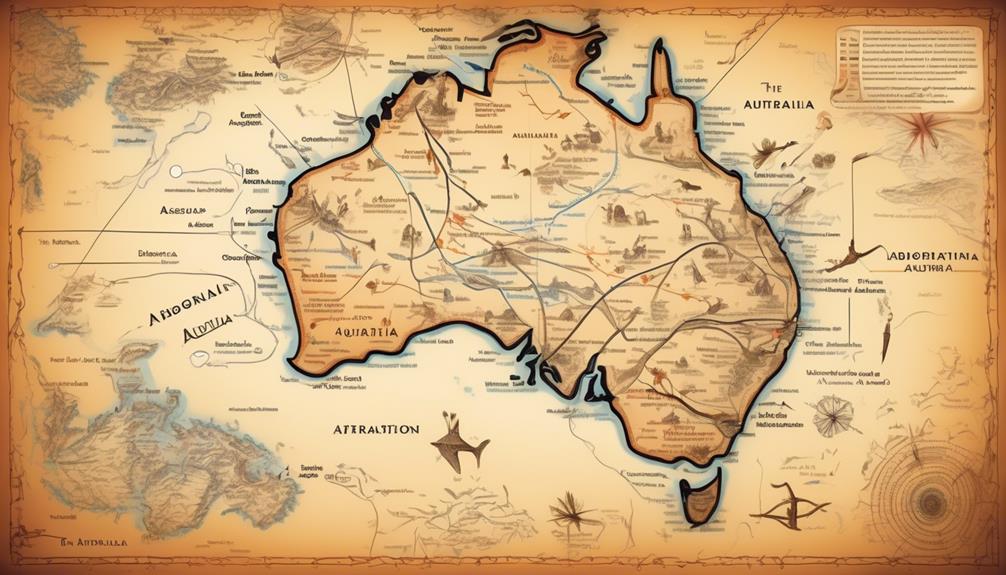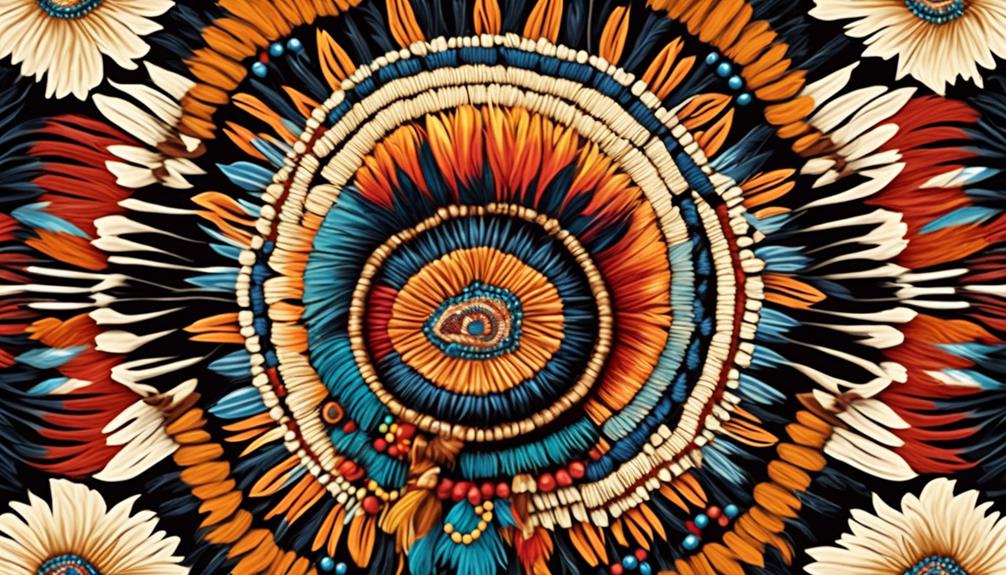Australian Aboriginals arriving to the continent is one of the most fascinating examples showcasing the remarkable diversity of human migration.
The question of how this ancient population actually made it to Australia is a puzzle that continues to intrigue researchers and spark lively debate.
As we explore the various theories and evidence surrounding this migration, we begin to unravel a complex story that challenges our understanding of early human movement and adaptation.
Key Takeaways
- Aboriginal Australians migrated to Australia from Africa and Southeast Asia, showcasing remarkable navigational skills.
- Theories on ancient migration include Coastal Migration Theory, Inland Route Theory, and Island Hopping Theory, all of which are supported by archaeological findings and genetic studies.
- Early Aboriginal Australians honed their seafaring and navigation skills, utilizing celestial patterns, natural landmarks, and observation of marine life and seabirds.
- They adapted to changing coastlines, utilizing land bridges for exploration and migration, highlighting their adaptability and resilience.
The Origins of Aboriginal Australians
The origins of Aboriginal Australians can be traced back tens of thousands of years, with evidence suggesting their presence in Australia dating back to at least 65,000 years ago. Through archaeological findings and genetic studies, it's understood that the ancestors of Aboriginal Australians made their way to the continent from Africa and Southeast Asia. This journey involved complex maritime migrations, showcasing the remarkable navigational skills and knowledge of the environment possessed by these early peoples.
Ancestral connections for Aboriginal Australians are deeply rooted in the land, forming the basis of their cultural identity. The preservation of their cultural heritage is of utmost importance, as it encompasses traditions, storytelling, art, and spiritual beliefs that have been passed down through generations. This preservation is crucial not only for the Aboriginal communities themselves but also for the broader understanding of humanity's diverse cultural tapestry.
Understanding the origins of Aboriginal Australians and the ways in which they've maintained their ancestral connections and preserved their culture provides valuable insights into the richness and resilience of indigenous communities. It also serves as a reminder of the importance of respecting and learning from diverse cultural traditions.
Ancient Migration Theories

Ancient migration theories offer valuable insights into the ancestral journeys and navigational prowess of early Aboriginal Australians, shedding light on the complex movements that brought them to the continent tens of thousands of years ago. These theories are crucial in understanding the rich tapestry of ancient migration and cultural exchange that shaped the history of Aboriginal Australians. Below is a table summarizing some prominent ancient migration theories:
| Theory Name | Key Points | Supporting Evidence |
|---|---|---|
| Coastal Migration Theory | Suggests migration occurred via coastlines, | Archaeological findings of early coastal |
| taking advantage of maritime resources. | settlements and evidence of seafood consumption. | |
| Inland Route Theory | Proposes migration through inland routes, | Genetic studies indicating diverse Aboriginal |
| utilizing river systems and resources. | Australian lineages and ancient trade networks. | |
| Island Hopping Theory | Posits migration through island hopping, | Similarities in material culture between |
| using islands as stepping stones. | Aboriginal Australians and Southeast Asian groups. |
These theories collectively contribute to our understanding of ancient migration patterns and the cultural exchange that occurred as Aboriginal Australians traversed diverse landscapes to reach and settle in Australia.
Early Seafaring and Navigation Skills
Utilizing their inherent knowledge of celestial patterns and natural landmarks, early Aboriginal Australians honed their seafaring and navigation skills, enabling them to traverse vast distances across the coastal regions. Seafaring techniques employed by these ancient mariners included reading ocean currents, wave patterns, and wind directions to navigate their canoes. By observing the behavior of marine life and seabirds, they were able to anticipate the proximity of land and potential hazards.
Additionally, Aboriginal Australians developed sophisticated navigation methods, using the positions of stars, sun, moon, and other celestial bodies to chart their courses. They also utilized the knowledge of seasonal changes and the movement of constellations to guide their journeys.
The mastery of these seafaring techniques and navigation methods allowed early Aboriginal Australians to establish extensive trade networks, exchange cultural practices, and engage in social interactions with distant communities. These skills also facilitated the exploration and settlement of new territories, contributing to the rich tapestry of Aboriginal cultures across the continent.
The legacy of their maritime expertise endures as a testament to the ingenuity and adaptability of the first Australians.
Land Bridges and Changing Coastlines

Mastering the seafaring techniques and navigation methods allowed early Aboriginal Australians to expand their exploration as they adapted to changing coastlines and utilized land bridges. The land bridge theories and coastal migration routes are essential components in understanding the historical movement of early Aboriginal Australians.
The concept of land bridges provides a tangible connection to the past, allowing us to envision the physical pathways that ancient peoples may have traversed.
Exploring the changing coastlines evokes a sense of adaptation and resilience in the face of environmental shifts, highlighting the resourcefulness of early Aboriginal Australians.
Considering coastal migration routes fosters a deep appreciation for the ancestral knowledge and skills that enabled successful navigation across vast stretches of ocean.
The land bridge theories and coastal migration routes offer a glimpse into the intricate web of factors that shaped the migration patterns of early Aboriginal Australians. Understanding these concepts not only enriches our historical perspective but also honors the ingenuity and adaptability of the ancestors who laid the foundation for our world today.
Genetic and Archaeological Evidence
Recent genetic and archaeological evidence sheds light on the ancestral origins and historical migration patterns of early Aboriginal Australians. Genetic studies have shown that Aboriginal Australians are one of the oldest continuous cultures outside of Africa, with an ancestry dating back around 50,000 years. These studies have revealed that their ancestors were the first modern humans to cross the sea from Southeast Asia. Additionally, archaeological findings support the genetic evidence, providing further insight into the journey of these early settlers.
| Genetic Studies | Archaeological Findings | Migration Patterns |
|---|---|---|
| DNA analysis indicates deep-rooted ancestry | Stone tools and artifacts suggest migration routes | Patterns of settlement and adaptation |
| Mitochondrial DNA links to specific regions | Rock art and engravings depict cultural practices | Use of fire and land management techniques |
The interplay between genetic and archaeological research has allowed us to piece together a more comprehensive understanding of the complex history of Aboriginal Australians. It has not only provided insights into their ancient past but also highlighted the resilience and adaptability of these remarkable communities. This knowledge is invaluable in preserving and appreciating the rich cultural heritage of Aboriginal Australians.
Frequently Asked Questions
What Are Some Traditional Aboriginal Australian Migration Stories and Beliefs?
Traditional beliefs of Aboriginal Australians are rich with migration stories that are deeply intertwined with cultural practices and survival strategies. These stories often speak of ancestral journeys across the land and sea, reflecting the deep connection to the environment.
These narratives highlight the resilience and adaptability of Aboriginal people, emphasizing the importance of passing down these stories to preserve their heritage and traditions.
How Did Aboriginal Australians Adapt to and Survive in the Diverse Australian Environments?
We've marveled at the remarkable adaptation strategies and survival techniques of Aboriginal Australians in diverse environments. Their profound understanding of the land, resourcefulness, and sophisticated knowledge of flora and fauna enabled their survival.
Through intricate fire management, hunting, and gathering practices, they thrived in what may seem like inhospitable conditions to others. Their ability to adapt and thrive in such diverse environments is a testament to their ingenuity and resilience.
What Impact Did Early Aboriginal Australian Migration Have on the Continent's Biodiversity and Ecosystems?
Early Aboriginal Australian migration had a significant impact on the continent's biodiversity and ecosystems. Our understanding of these impacts is shaped by both archaeological evidence and traditional beliefs.
The movement of people across the land resulted in the introduction of new plants, animals, and land management practices, influencing the development of diverse ecosystems.
This early migration continues to shape the biodiversity of Australia, illustrating the deep connection between Indigenous peoples and the environment.
Are There Any Modern Aboriginal Australian Cultural Practices That Can Be Traced Back to Their Ancient Migration and Settlement?
Modern practices in Aboriginal Australian culture can be traced back to their ancient roots, showcasing cultural continuity and migration narratives. These practices reflect a deep connection to the land, spirituality, and traditional knowledge systems.
Rituals, art, storytelling, and land management techniques all carry echoes of the past. Understanding these connections provides insight into the enduring legacy of the first peoples of Australia and their remarkable ability to maintain and adapt their traditions over time.
How Did Interactions With Other Ancient Civilizations and Cultures Influence Aboriginal Australian Migration and Settlement Patterns?
Interactions with ancient civilizations greatly influenced Aboriginal Australian migration patterns and cultural influences. These interactions shaped our ancestral movements and settlement choices, impacting our traditions and way of life.
The exchange of knowledge and ideas with other cultures left a lasting imprint on our migration history, contributing to the rich tapestry of Aboriginal Australian heritage. Such interactions continue to shape our identity and cultural practices to this day.
Conclusion
In conclusion, the journey of how Aboriginal Australians actually got to Australia is a complex and fascinating story.
Through ancient migration theories, early seafaring and navigation skills, land bridges, changing coastlines, and genetic and archaeological evidence, we've gained a deeper understanding of their origins.
Like a river flowing through time, their history is a winding path that has shaped their culture and identity in unique and profound ways.
Mary is a passionate writer who brings creativity and a fresh perspective to our team. Her words have the power to captivate and inspire, making her an essential contributor to our content. Mary’s commitment to storytelling and dedication to promoting Indigenous culture ensures that her work touches the hearts of our readers. We’re fortunate to have her as part of our team.










